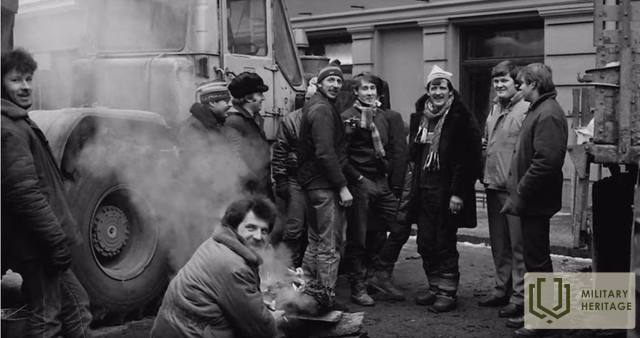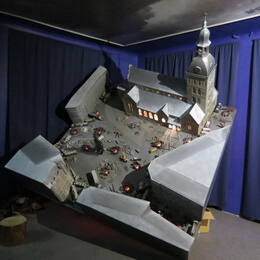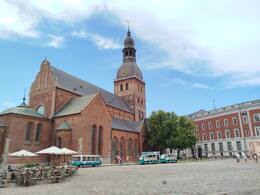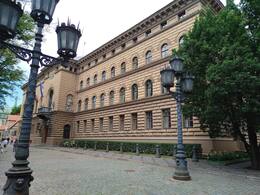Memories of Kocēnietis Tālavs Megnis about the events at the 1991 barricades in Riga
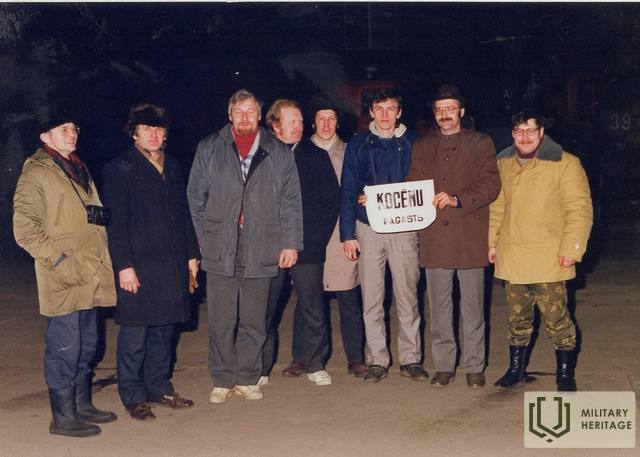
Memories of Kocēnietis Tālavs Megnis about the events at the 1991 barricades in Riga.
"On January 13, about 40 Kocēni residents left the collective farm in an organized manner for a demonstration in Riga on the Laz bus, driven by Vitaly Sprukts, and the Latvija minibus, driven by Jānis Grava.
After the demonstration, when we met at the buses, we heard the Latvian People's Front's call on the radio several times for those who can to stay in Riga and defend strategically important objects to make their capture more difficult, similar to what happened at Vilnius Television. We saw these footage filmed by Podnieks before leaving for Riga.
I, Tālavs Megnis, had just started working in the Kocēni parish municipality in January as a land planner for the implementation of the land reform. After consulting with each other and with the collective farm specialists, chief accountant Ruta Rozenberga, accountant Gaida Raga and dispatcher Liene Kūna and the 1st district agronomist Ilga Brusova, minibus Latvija driver Jānis Gravas and others, we decided that those who wanted to would stay in Riga, responding to the call of the Popular Front. I told my colleagues from the collective farm that I could not go to work on Monday, because if our new government fell, then the land reform would definitely not happen, but if it held out, then the absence from work would be forgiven.
On the night of January 13 to January 14, Jānis Grava - the driver of the Latvija minibus; Jānis Olmanis - a music teacher at Kocēni Primary School; Tālavs Megnis - the land surveyor of Kocēni parish, previously the head of the precinct at the collective farm "Kocēni", was chosen as the leader of the group that remained in Riga; Dainis Ābelītis - from the "Strautnieki" houses, a collective farm worker-driver; Juris Miķelsons; Uldis Rolmanis - at that time a worker-driver at the MRS (Forestry Enterprise); Aivars Vīksne - a builder from the construction crew.
When the others left, we drove our minibus to the entrance to the Cabinet of Ministers, in the courtyard from Brīvības Street. Then we got out of the bus, walked to the main entrance, where there were already two people in front. We talked about what we were going to do with our naked lives here now, or feed the cannons - we laughed. We got to know each other, the first two were men from Cēsis, I don't remember what their names were. Every now and then someone else came, a few cars also stopped and also a bus with people from the demonstration, it seems that they were from Ādaži. We decided that we didn't know what to do anymore, but we would stand there for a while, let's see what happens. The bus left after a while, wishing us support.
After a while, actress Dina Kuple and another woman came to our group. They were very happy that we were standing here and begged us not to leave and help protect Riga. So that we wouldn't freeze here, they left us a small balsam wrapped in newspaper. It was getting dark.
After a short time, two young people approached us as students, asking where we were from, who was the oldest or the group leader. We are seven people from Kocēni, in the Valmiera district, with a minibus "Latvija", if necessary, I can also be the group leader. Then I went with those boys to their Zhiguli, it was probably white or yellowish in color. It was parked at the end of the Cabinet of Ministers building, on the side of the Freedom Monument, in Bauman Square. We got to know each other, but I don't remember our names anymore. There was a walkie-talkie in their Zhiguli. Then they contacted the Popular Front headquarters and reported that they had seven beers and one polš and could get more - I understood that it was seven men and one transport unit. Those boys instructed me that we needed to stop the vehicles and invite people to stay at this object, and at first to form a human chain around the entire building. They also asked if we could see what was happening at the international telephone exchange on Dzirnavu Street and whether we were ready to take on another task. I replied that we would do whatever was necessary. Then they left, having told me to come to this car myself when they returned here, or to another place to receive new tasks. In the bus, we continuously listened to the information of the Popular Front, which was broadcast on the radio from time to time.
Acting on instructions, we began to stop cars much more actively and to address people to stay and be, if only as witnesses, of what was happening here in the future. People were generally responsive, and both Riga residents and passers-by began to linger at the building. Several young people who had come from the Limbaži district got off a bus carrying participants in the demonstration, and after a couple of hours about a hundred people had gathered here.
Leaving the other members and the bus at the Cabinet of Ministers, Jānis Olmanis and I walked to the telephone exchange building on Dzirnavu Street. At that moment, at the end of Čaka Street, Dzirnavu Street was blocked by a large KrAZ truck-trailer with a T130 bulldozer on it. There were quite a few people on the street. On the side of the street opposite the telephone exchange, a barricade was spontaneously built from the construction materials of a house that was being reconstructed or demolished. Two sharp young girls, high school students, perhaps students, could not tear off the boards from an old high wooden fence and called out to Jānis and me: "Oh, well, help tear down the fence, what are you looking at!"
Not even five minutes passed when the farm was already across the street, along with all sorts of junk, old beds, barrels, chairs and wardrobes. When there was nothing left to carry, we walked back to the Cabinet of Ministers to our group. Soon, some trucks with gravel and rubble arrived, and later a Ural truck - a timber carrier with logs.
Soon, a Zhiguli with the Popular Front boys arrived at the agreed place again. Having approached them, I got into the car. The young people asked if we could go out in our van to see what was happening near some Soviet military units. I said that we definitely could, we just had to talk to the others. They said that they would bring another person, and that we should get ready to go.
Grava Jānis, of course, was ready to go, and after a few minutes the students brought two people in their 30s and a walkie-talkie. Perhaps one introduced himself as Druvis. Some of our group stayed at the Cabinet of Ministers, and we drove in the direction of Jugla to what is now Krustabaznīcas Street, then along Viskaļu and Ezermalas Streets. Then along Meža prospekts and Viestura prospekts to the OMON base in Vecmilgrāvi. Druvis periodically reported to his headquarters about the army vehicles he had seen, BTRs (armored personnel carriers), their number, brands, the soldiers he had seen in them, and the directions they were moving. Apparently, the military units were on high alert, because in several places we saw sentries with machine guns on their shoulders on the streets.
From Vecmilgrāvi through the center we drove to the Salu bridge to assess the situation at the Television Center in Zaķusala, where the Kurzeme residents were invited. The Salu bridge and the Television Center were already completely blocked - with cars, heavy agricultural and construction machinery, reinforced concrete blocks. Somewhere anti-tank hedgehogs were welded right on the street. It was possible to move across the bridge with great difficulty and only in one lane. There were many barricade participants and the National Guard. We were stopped several times and sometimes quite aggressively asked who we were and where we were going. We explained ourselves and crossed the bridge in about an hour. Then we returned to the center via the Akmens bridge. Druvis thanked us with a walkie-talkie and his colleagues for their help and said that they would go further on their own. Some of us went as far as the Supreme Council building, now the Saeima on Jēkaba Street. Old Riga was already completely barricaded with heavy equipment, which had been packed so tightly together that only one could get out at a time to get ahead. One narrow street was completely blocked by the largest wheeled tractor T 700, which was difficult to pass. Reinforced concrete blocks were being piled up on Jēkaba Street, forming a labyrinth. Seeing all this, I was convinced that we were all a huge, incomprehensible force together. Although we have no weapons and are only "cannon fodder", the unity of all of us is a fortress of bare lives and equipment, the capture of which would require the use of enormous, unprecedented, brutal, bloody force against peaceful residents, as was the case in China in Pyongyang Square against students several years ago, where they were dragged through tank chains. Who could give such an order - to launch hostilities against an unarmed people? Impossible.
Therefore, Soviet functionaries later devised an attack on the Ministry of the Interior, which did not support the Communist Party's efforts to preserve Soviet power, but was with the barricade participants in spirit and conviction.
Returning to the Cabinet of Ministers, the remaining members of the group saw that this building was comparatively the least protected, because it was large enough, located in the middle of wide streets, and a few more trucks that arrived did not create significant obstacles to the violent seizure of the building, because only the Brīvības Street side was somewhat blocked, but from the Elizabetes and Tērbatas Street sides there were only a few cars and also our minibus "Latvija".
Then, after discussing, we decided that we should invite our people from Kocēni with their big T150 tractors. I went somewhere near the cinema "Pionieris" or "Rīga" and from a payphone, it could have been around 23.00 - 24.00, I called Vitautas Staņas, the chief engineer of the collective farm "Kocēni", because I knew that he would support this event. After briefly describing the situation in Riga, I said that they should try to organize as many tractors to Riga as possible, without which they could do without to ensure production. I suggested that they offer to ride to our skijoring team riders, brothers Juris and Jānis Caunės, Guntis Skrastiņš, Guntis Zēvalds, Juris Bečeris and others, because I was their coach and I knew that they would not refuse and that they could be relied on in any situation. Then we returned to the bus, and realizing that we had to wait for morning and reinforcements, we chatted and warmed ourselves with the balsam left by Dina Kuple. Somewhere on the Vērmaņdārzis side, a small fire had already been lit, there was not much firewood left. The night was very damp and cold.
After midnight, the trolleybuses did not go to the garages, but were parked close to each other around the entire Cabinet of Ministers building, sometimes in two rows, where there were no other vehicles. Immediately after eight, I called the chief mechanic again, asked what the situation was, and whether we could expect any equipment from Kocēni. Vytautas replied that some of them were already being refueled, and work was being planned so that potential passengers could go to Riga without disrupting production. I also informed him that there was no wood in Riga to burn in the fires, and I ordered that all tractors, before leaving, go to the sawmill and load the sawlogs - the leftovers from sawing logs, which were standing there in large quantities at that time and were a burden on production.
On the morning of January 14, three or four T150 tractors with trailers left for Riga, having previously loaded firewood into the shed. The following is a list of barricade participants who arrived in Riga with collective farm equipment.
As I thought, around noon, Juris Caune arrived at the Cabinet of Ministers in Riga with an MTZ 82 tractor and three T150 tractors with trailers. Jānis Caune, Guntis Skrastiņš, Juris Bečers arrived with them, together with Guntis Zēvaldas, Guntars Konāns, Juris Tīliks or Andis Bērziņš. The tractor trailers, as I had already indicated, were loaded with firewood for bonfires. After a short time, the tractors were sent to block Dzirnavu Street near the telephone exchange. Our collective farm equipment was also parked here during the entire barricades. Only Guntis Škrastiņš was on the Brasa Bridge with his tractor for some time, the day after the first tragic events. During the riot police attack, A. Bāliņš from Kočeni was also parked there with his Kamaz truck.
To warm ourselves and fry sausages, we lit a fire right on the street between the tractors. Later, someone had brought or brought a large cast-iron pot in which soup or some kind of porridge was cooked. Every day, new barricade participants came from the collective farm for shifts. I remember that later Jānis Krīgers, Aivars Rags with his daughter Sanita, Jānis Jēgers, Juris Fridvalds, Kārlis Koķis, Vitālijs Bečers, Edgars Bečers, Uldis Lukss, Jānis Trēziņš and others arrived. Of course, it is difficult to remember everyone. Gas masks were also taken from the collective farm reserves. Just in case.
The friendly and supportive attitude of the surrounding residents of all nationalities towards our presence in Riga and our protection was fantastic. Many came up to us and encouraged us, brought us thermoses of tea and cigarettes. I remember that one evening a Russian woman brought me a large plate of warm, freshly baked pancakes and a bottle of vodka bought with coupons, because she herself did not drink, but it would be useful for us to be warmer at night. She also told us a lot about her life and why she was happy about a free Latvia.
I remember one day, I don't remember which of the people sitting in the tractors had noticed that two men in their prime were walking slowly between the tractors, watching everything, talking to each other, one taking photos every now and then. Just suspicious types. We thought that Cheka agents were collecting information about access to the Telephone Exchange. We went over and started to tease them about who these spies were, because they didn't behave like correspondents or simply interested people, which many had already been seen with cameras. After quite a long discussion, we realized that these observers were also our own, but with a different perspective and a desire to immortalize this situation or a moment in history.
After the tense situation of the first night, the following nights were relatively boring and monotonous. Some nights it was also quite cold, it seems that even down to about -15°. Then we went to a nearby cinema and watched a movie, because films were shown continuously, it seemed, 24/7 and for free. Two nights for a couple of hours, I had also returned to sit and warm up in the Dome Church. It was not quite as warm there in terms of degrees, but the peace that reigned there is indescribable. A short meditation in the coldest, most guarded haven of peace gave me strength, faith and confidence that we were on the right track. One corner of the church was prepared for receiving the wounded. It seems that there were several dozen stretchers, dressing materials and medicines there.
I also remember that a large screen was later installed near the Cabinet of Ministers, on which information from CNN was continuously shown about events in Latvia, Kuwait, Desert Storm, and elsewhere in the world.
On the evening of January 20, when the Ministry of the Interior was taken, I had left for Valmiera on another collective farm bus. I wanted to go home to my family to warm up and take a shower. My wife Gunta had already left for Valmiera with the children to visit her mother, because her birthday was on January 20. I also went straight to the birthday girl. When I entered the apartment around nine in the evening, I remember that the television was already showing footage from the center of Riga, where the attack on the Ministry of the Interior took place, how the wounded Gvido Zvaigzne and Andris Slapiņš were being carried on a stretcher. My mother-in-law Hedviga was crying. My father-in-law Ēvalds, an old soldier, was thoughtfully silent. I had two feelings: on the one hand, joy that I was home, warm with my family, but on the other hand, that I was not there, in Riga, with the barricades. How would it all end? The next day we took another bus to Riga..."
Memories of Tālavs Megns
Related timeline
Related objects
1991 Barricades Museum
The museum is located in Old Riga near the Riga Cathedral. It was founded in 2001 to preserve historical evidence of the events of 1991 in Latvia. A virtual tour of the museum is also available. In January 1991, in Lithuania the Soviet Army opened fire on people who had gathered at the Vilnius TV tower and drove into the crowd with tanks. In response to these events a demonstration of about 500,000 people was organised in Riga to show support to Lithuanians and the readiness of the Latvian people to continue their struggles towards Latvia’s independence. In order to prevent similar events from happening in Latvia, residents began to build barricades in the narrow streets of Old Riga in order to prevent possible attacks of the Soviet Army on the defenders of the barricades. These barricades were also created at various strategic objects not only in Riga, but throughout all of Latvia. Around 50,000 people from all over Latvia participated in defending the barricades. Barricades was a popular movement that helped to regain Latvia’s independence. This is a great example of non-violent resistance in the history of the whole world.
Vaidava Parish Local History Permanent Exhibition
Located in the Vaidava Culture and Crafts Center.
An exhibition dedicated to the memory of the deportations of 1949, as well as the participation of the Vajdavians in the barricades in Riga in January 1991, is on display. The exhibition also features evidence of the world wars (mainly printed materials).
Natural and historical objects, manors, history of education, culture, notable people, materials from the collective farm era, household utensils, banknotes, newspapers, magazines about Vaidava parish.
Dome Square in Old Riga
The importance of Dome Square during the Awakening was determined mainly by two circumstances – it was located in the immediate vicinity of the building of the Supreme Council of the Latvian SSR, as well as the fact that the building of Latvian Radio is located on the square. Various actions were held on Dome Square, putting forward demands to the Supreme Council, for example, on July 26, 1989, the Latvian Federation of Labor organized a rally attended by 60,000 people, demanding that the Supreme Council adopt the Declaration of Sovereignty. It was at this rally that the then popular slogan “Something in the past, but in free Latvia” was raised.
Dome Square was the main gathering place for the defenders of the barricades in January 1991, protecting the Supreme Council and the Radio House. The defenders of the barricades warmed themselves by the bonfires. They also stayed in the Radio House and the Dome Church. A first aid station was set up in the church, and services were held. In the evenings, popular rock bands performed on an improvised stage in the square. Every year, events commemorating the barricades are held in Dome Square.
Near the Dome Square, at Krāmu Street 3, there is a museum of the 1991 barricades. On January 13, 2018, the stained glass window “With passion for a free Latvia” by artists Krišs and Dzintars Zilgalvji was unveiled in the Dome Church - a dedication to the 1991 barricades and the independence of Latvia.
Parliament House (Saeima)
The former Vidzeme Knights' House has been the home of the Latvian Parliament since 1922. During the Soviet occupation, a pseudo-parliament - the Supreme Council of the Latvian SSR - was located here. In the elections to the Supreme Council held in March 1990, the main issue was the restoration of Latvia's state independence. This was done in accordance with the position of the Latvian Popular Front, which stated that it was more realistic to do this using the existing power structures of the USSR. In order to win a qualified vote in the Supreme Council, 134 votes were needed.
On May 4, 1990, the Supreme Council of the Latvian SSR adopted the Declaration “On the Restoration of the Independence of the Republic of Latvia”. 138 voted in favor of its adoption, 1 abstained, but 57 deputies who advocated Latvia remaining part of the USSR did not participate in the vote. By adopting the Declaration, the 1922 Constitution was restored in the territory of Latvia, but until the adoption of a new version of the Constitution, its operation was suspended, except for the first three articles of the Constitution. Such a transitional period was determined until the convocation of the Saeima of the Republic of Latvia. May 4 is celebrated as the Day of the Restoration of the Independence of the Republic of Latvia.
On May 15, 1990, opponents of independence attempted to seize the Supreme Council with the help of military cadets dressed in civilian clothes, but the spontaneously organized students of the Polytechnic Institute and the Institute of Physical Culture repelled the attack. The second attempt to attack the Supreme Council was stopped by the militia (the OMON unit, which in June 1990 refused to submit to the government of the Republic of Latvia and became the main strike force of the opponents of independence).
The Supreme Council was one of the most important points of barricade protection in January 1991. The approaches to it were fenced off with reinforced concrete blocks, and these protective structures were there until the unsuccessful coup attempt in Moscow on August 19-21, 1991. Soviet paratroopers and OMON fighters were unable to occupy the Supreme Council, and its deputies continued their work. On August 21, at 1:00 p.m., four OMON armored personnel carriers entered the Dome Square and remained there until 2:10 p.m., trying to intimidate the deputies, who at that time (at 1:10 p.m.) adopted the Constitutional Law on the State Status of the Republic of Latvia (111 deputies voted for, 13 against). This abolished the transitional period established on May 4, 1990 for the de facto restoration of state power in the Republic of Latvia, and Latvia regained full independence. In 2007, a memorial site for the January 1991 barricades was opened near the Saeima building on Jēkaba Street, and in 2000, in honor of the 30th anniversary of the restoration of the independence of the Republic of Latvia, a commemorative plaque was installed next to the main entrance of the Saeima with the inscription: "In this building, on May 4, 1990, the deputies of the Supreme Council adopted a declaration on the restoration of the independence of the Republic of Latvia."
Bastejkalns neighborhood in Riga
The area around Bastejkalns includes several memorial sites from the barricade era. The square, located at the intersection of Smilšu and Torņa streets, opposite the Powder Tower, was named the 1991 Barricade Square in 2016. The heavy equipment stationed here protected Old Riga from invasion at a strategically important location. The nearby Latvian War Museum housed barricade post no. 1.
On January 20, 1991, an OMON attack on the Ministry of Internal Affairs took place in the vicinity of Bastejkalns, which took the lives of several people. In the canalside greenery, opposite Bastejkalns, at the places where the victims were mortally wounded, memorials have been erected - stones to militia lieutenant Vladimir Gamanovič, inspector of the internal affairs department Sergejs Kononenko, director of the Riga Film Studio Andris Slapiņš, schoolboy Edijs Riekstiņš and the shot cameraman Gvido Zvaigznes, who died on February 5. There is a version that the shooters were not only and not so much OMON members, but also some “third force” - either from the special unit “Alfa”, or employees of the USSR State Security Committee from Moscow, who provoked the OMON attack on the Ministry of Internal Affairs.
A memorial stone has also been installed in the canalside gardens to the victim of August 19, 1991, Raimonds Salmiņš, who was shot by riot police near the Riga City Police Department building at the intersection of Aspazijas Boulevard and 13. janvāra Street. In 2014, a memorial plaque dedicated to the victims of the January 20, 1991 attack on the Ministry of the Interior was installed near the former Ministry of the Interior building at the corner of Raina Boulevard and Reimersa Street.




